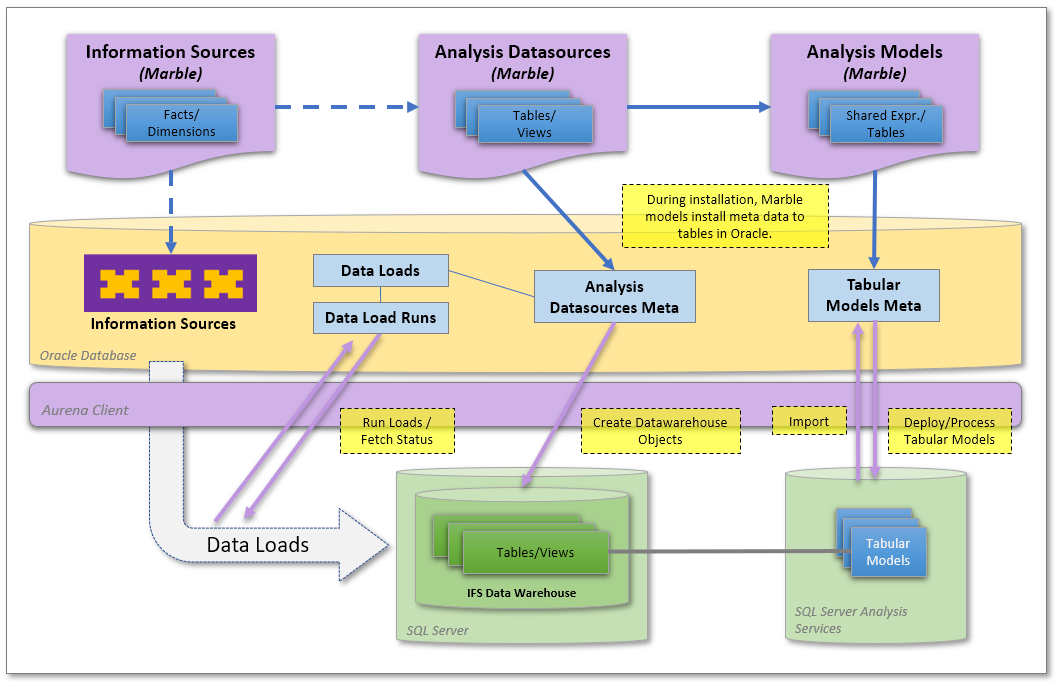IFS Analysis Models¶
IFS Analysis Models consists of a framework that supports transferring data from IFS Cloud Information Sources to a Data Warehouse hosted in Microsoft SQL Server, and a set of Microsoft Tabular Models connecting to this Data Warehouse.
The definition of the Data warehouse and the Tabular Models are done using Marble models and supports the layered application architecture.
The deployment of the Data warehouse and the Tabular Models are done through Aurena.
Further functions like data loading, data configuration, scheduling, monitoring and processing of tabular models are also done through Aurena.
Architectural Overview¶

Definition of Data Warehouse¶
The data warehouse contains tables, views and indices on tables. All objects found in the data warehouse is defined using a collection of Analysis Data sources.
Analysis Data Source¶
An Analysis Data Source marble models install meta data for Tabular Data Sources. Refer the section Tabular Data Sources for more details.
Definition of Tabular Models¶
The tabular models are abstracted into Marble models as analysismodel files. One analysismodel file represents one Tabular Model along with all shared expressions, tables, hierarchies etc.
The marble models will generate insert scripts and they will get installed to the Oracle database during IFS installation.
The current release only supports Tabular Models of compatibility level 1400.
Definition of Data Loads¶
Loading of tables in the data warehouse needs to be defined using data loads. A data load can specify one or more Analysis Data sources.
Once defined each data load definition can be run multiple times.
Basic Data in IFS Cloud¶
IFS Analysis Models requires that basic data has been set up properly in IFS Cloud.
Configuration of Data Mart Load in IFS Cloud¶
In a practical scenario Data Mart access is essential to make sure that data access is as efficient as possible. Learn more Data Mart access and associated configuration in IFS Cloud.
Access Views¶
Extracting data from IFS Cloud to the Data Warehouse in SQL Server is done by using Access Views. These views represent the read interface in IFS Cloud, acting as a view layer on top of the Information Source related views.
Note: Access Views are not available by default. It is necessary to generate these views via the IFS Aurena client.
Learn more about Access Views.
Security¶
This section deals with read access related to IFS Cloud and also provides some information about security handling in SQL Server. Learn more about security.
Setup Environment and User Mappings¶
Data Configuration¶
Analysis Models provides data configurations that will limit the data used by the Tabular Models. The configurations are important to make sure that the Tabular Models work as designed to provide the end users with the best experience.
Data configurations are mainly related to basic data in IFS Cloud. For more information please refer to Basic Data in IFS Cloud.
Learn more about data configurations.
Setting up a Tabular Model¶
Before a Tabular Model can be used there are a number of setup steps that have to be completed.
Admin & Config Client Overview¶
Use the following link to get an overview of available client support in IFS Cloud related to the Tabular framework in Analysis Models.
Read more about available Admin and Configuration support for Tabular Models in Aurena client.
Deploy Necessary DW Objects¶
Each tabular model is dependent on a number of Tabular Data Sources. Before a model can be used, it is important to make sure that necessary Tabular Data Source specific objects are created in the the SQL Server database,
Learn more about DW deployment.
Data Load Definition and Volume Configuration¶
The Analysis Models framework, supporting SSAS Tabular models, transfers data from IFS Cloud to a storage layer, database, in SQL Server.
The data load supports different load types, providing flexibility to control the data volume loaded for different sources used by the Tabular models:
- Full load
- Conditional load
- Incremental load
Learn more how to create a data load definition and how to configure the data volume.
Custom Configurations¶
The Tabular Models framework is built around IFS Marble models and support a layered architecture that allows custom specific configurations. Read more about how to use the layered architecture to handle custom specific modifications and additions.
Read more about Tabular Models specific custom configurations.
Logs¶
The Tabular Models framework supports several actions that leads to execution of SSIS packages, Stored procedures and Agent Jobs in SQL Server. To enable tracing of these remote executions,a set of logs have been made available in the Aurena client.
Read more about available logs.
Translations¶
Read more about how translations are handled.
Other Subjects¶
Information related to installation and preparations can be found in the Installation Checklist.